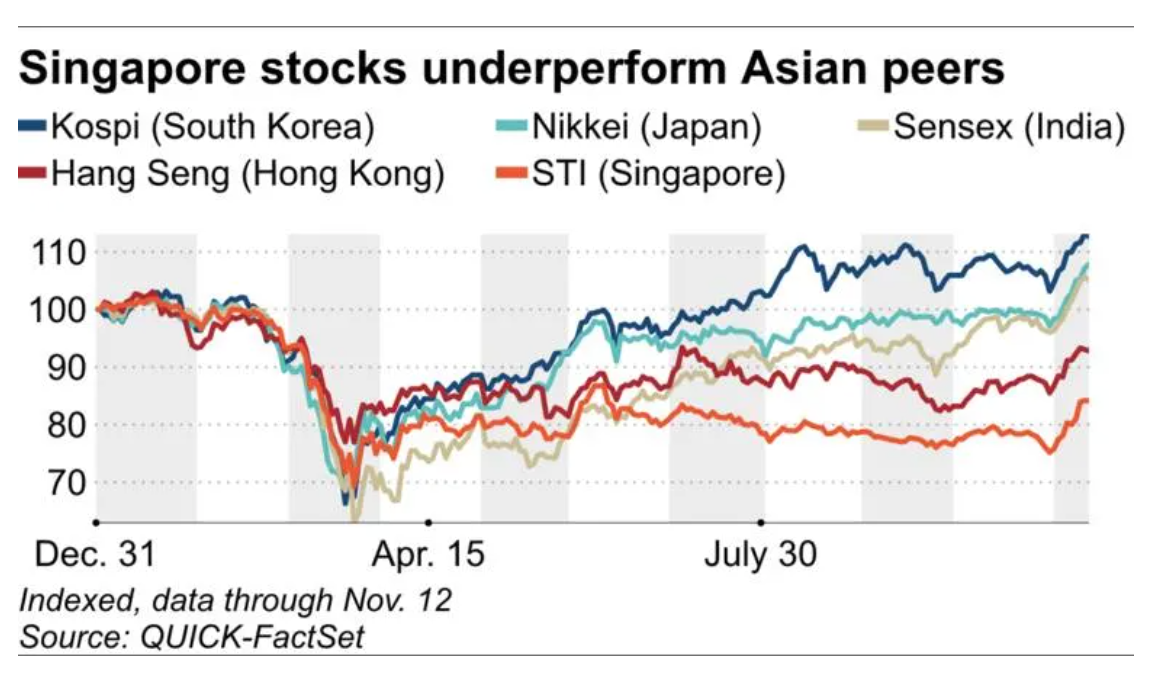Late last month, Singapore’s investors flocked to a little-known company that debuted on the local exchange — hoping to capture some of the magic of high-flying technology stocks that the city-state’s market has long been missing.
In what was the biggest IPO on the Singapore Exchange (SGX) in years for a company other than a real estate investment trust, Nanofilm Technologies International made its debut on Oct 30, raising over SGD 470 million Singapore (USD 340 million).
Its share price jumped above SGD 3.00 in early November — more than 15% higher than the IPO price of SGD 2.59 — bringing its market capitalization to about SGD 2 billion. It closed last week at SGD 2.93.
A nanotechnology solution provider for smartphones and other electronics, the tech newcomer’s positive debut is in contrast to Singapore’s lackluster stock market performance. The benchmark Straits Times Index was down 16% from the beginning of this year as of Nov. 12, far underperforming its Asian peers such as South Korea’s Kospi (+13%), Japan’s Nikkei Stock Average (+8%), and India’s BSE Sensex (+5%).
One of the reasons for the slump is that Singapore, despite being one of Asia’s economic hubs, lacks fast-growing tech stocks — companies such as Alibaba Group Holding, Meituan, and Amazon.com, which have boomed on the back of pandemic-driven digitalization.
The obsession with tech stocks seen elsewhere in the world has made it tough for Singapore to drum up investor interest — the largest capitalized companies on the SGX are legacy ones from traditional sectors like real estate, transport, leisure, telecommunications, and finance.

Singapore’s heavy dependence on the external environment to do well as an export-oriented economy makes its companies especially vulnerable to global shocks, such as the one triggered by the COVID-19 pandemic.
“Singapore does not have a big domestic consumption base. As such, the pandemic-induced restrictions on travel, tourism and on retail and construction to some degree had disproportionate impact,” Jefferies analyst Krishna Guha told Nikkei Asia.
Many of the 30 companies forming the Singapore stock index, such as Singapore Airlines, DBS Group Holdings and property developer CapitaLand, have seen their share prices plunge amid the health crisis. The index is tilted significantly toward banks in particular, where earnings have come under pressure from low interest rates and which face rising non-performing loans as the COVID downturn drags on.
Moreover, even since before the pandemic, the Singapore stock market has faced low liquidity, leading many homegrown companies to choose overseas markets for their IPO. Those include online gaming and e-commerce group Sea, which went public on the New York Stock Exchange in 2017 and now is Southeast Asia’s most valuable company, as well as gaming hardware maker Razer, which is on the Hong Kong exchange.
Such a situation explains why the Nanofilm IPO was significant for Singapore, despite its relatively small size compared with recent major listings in Chinese or South Korean markets.
Nanofilm’s founder and executive chairman Shi Xu said in a statement on the day of its debut: “While Nanofilm is the first deep-tech company in many years to list on SGX’s mainboard, I firmly believe we will not be the last… SGX will be the listing hub for many deep-tech companies to come.”
Recent market statistics suggest the company could take advantage of rising activity by small investors, as the low interest rate environment prompts investors to look for alternative returns. In the three months through October Singapore-listed stocks received a net increase of SGD 2.1 billion of retail funds, while they saw a net outflow of some SGD 940 million from institutional investors, according to the SGX.
Max Loh, managing partner for Singapore and Brunei at Ernst & Young, said the Nanofilm IPO “could catalyze further interest in others choosing SGX as a listing destination. The ability to achieve a sustained ripple and sector cluster effect will bode well for what lies ahead.”
Yet, it will take a long time for Singapore to become a tech stock hub. “One tech IPO does not make SGX a Nasdaq… At a market cap of SGD 2 billion, it is still relatively small in the world of listed technology stocks,” Justin Tang, head of Asian research at United First Partners, told Nikkei. “Tech investors are likely to continue investing in the Nasdaq or Hong Kong when it comes to tech stocks like Alibaba.”
Referring to Nasdaq, which boasts companies like Amazon, Netflix, and Facebook, Tang said: “It’s about the entire ecosystem — from colleges that bred so many founders, industry and company cultures of openness, exchange of ideas and way of thinking, access to free flowing venture capital, to the infrastructure and of course size of addressable market.”
Looking ahead, without a sizable number of tech stocks the Singapore market’s recovery in the near term will likely depend on reopening of the local and the global economy. Singapore’s coronavirus situation has stabilized, with a single-digit number of new cases reported in recent days, and the country is speeding up its border reopening.
Carmen Lee, head of research at OCBC Investment Research, noted in a recent report that sectors which ride the global economic cycle “could see renewed interest once economic and corporate activities resume fully,” as more countries follow Singapore in emerging from various stages of COVID-induced shutdowns.
This article first appeared on Nikkei Asia. It’s republished here as part of 36Kr’s ongoing partnership with Nikkei.

